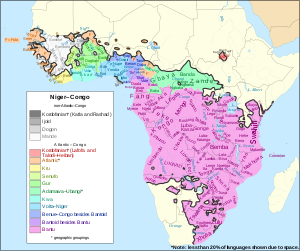The Atlantic–Congo languages comprise the largest demonstrated family of languages in Africa. They have characteristic noun class systems and form the core of the Niger–Congo family hypothesis. They comprise all of Niger–Congo apart from Mande, Dogon, Ijoid, Siamou, Kru, the Katla and Rashad languages (previously classified as Kordofanian), and perhaps some or all of the Ubangian languages. Hans Gunther Mukanovsky's "Western Nigritic" corresponded roughly to modern Atlantic–Congo.[1]
| Atlantic–Congo | |
|---|---|
| Geographic distribution | Africa |
| Linguistic classification | Niger–Congo?
|
| Subdivisions |
|
| ISO 639-5 | alv |
| Glottolog | atla1278 |
 The Atlantic–Congo languages shown within the Niger–Congo language family. Non-Atlantic–Congo languages are greyscale. | |
In the infobox, the languages which appear to be the most divergent are placed at the top.[2] The Atlantic branch is defined in the narrow sense, while the former Atlantic branches Mel and the isolates Sua, Gola and Limba, are split out as primary branches; they are mentioned next to each other because there is no published evidence to move them; Volta–Congo is intact apart from Senufo and Kru.
In addition, Güldemann (2018) lists Nalu and Rio Nunez as unclassified languages within Niger-Congo.[3]
There are a few poorly attested languages, such as Bayot and Bung, which may prove to be additional branches.[citation needed]
Comparative vocabulary
editSample basic vocabulary for reconstructed proto-languages of different Atlantic-Congo branches:
| Branch | Language | eye | ear | nose | tooth | tongue | mouth | blood | bone | tree | water | eat | name |
|---|---|---|---|---|---|---|---|---|---|---|---|---|---|
| "Western Nigritic" (roughly Atlantic–Congo) |
Proto-"Western Nigritic"[1] | *-nín-, *-nínu | *-thúi, *-thú- | *-míl-, *-míla | *-nín- (*-níghin-) | *-líma (*-líami); *-lélum- (*-lúm-) | *-níana; *-níuna (*-núa) | *-ghìá; *-kàl- | *-khwúpà | *-tí | *-lingi | *di- | *-ghínà |
| Benue-Congo | Proto-Benue-Congo[4] | *-lito | *-tuŋi | *-zua | *-nini, *-nino; *-sana; *-gaŋgo | *-lemi; *-lake | *-zi; *-luŋ | *-kupe | *-titi; *-kwon | *-izi; *-ni | *-zina | ||
| Bantu | Proto-Bantu[5] | *i=jíco | *kʊ=tʊ́i | *i=jʊ́lʊ | *i=jíno; *i=gego | *lʊ=lɪ́mi | *ka=nʊa; *mʊ=lomo | *ma=gilá; *=gil-a; *ma=gadí; *=gadí; *mʊ=lopa; *ma=ɲínga | *i=kúpa | *mʊ=tɪ́ | *ma=jíjɪ; *i=diba (HH?) | *=lɪ́ -a | *i=jína |
| Yoruboid | Proto-Yoruboid language[6] | *é-jú | *é-tí | *ímṵ́ | *éŋḭ́ | Yor. ahá̰ | *ɛ́lṵ ? | *ɛ̀-gyɛ̀ | *égbṵ́gbṵ́ | Yor. igi | *ó-mḭ | *jɛṵ | *órú- ? |
| Gbe | Proto-Gbe[7] | *-tó | *aɖú | *-ɖɛ́ | *-ɖũ; *-ɖũkpá | *-ʁʷũ | *-χʷú | *-tĩ́ | *-tsĩ | *ɖu | *yĩ́kɔ́ | ||
| Gur | Proto-Central Gur[8] | *me (Oti-Volta, Gurunsi) | *ye (Gurunsi, Kurumfe) | *ñam, *ñim (Oti-Volta, Kurumfe) | *ʔob, *ʔo | *tɪ (Oti-Volta, Gurunsi) | *ni, *ne; *nã (Oti-Volta, Gurunsi) | *di | *yɪɗ, *yɪd (Oti-Volta, Gurunsi) | ||||
| Gbaya | Proto-Gbaya[9] | *gbà.l̥í/l̥í | *zɛ̀rà | *zɔ̰̀p | *ɲín | *léɓé ~ lémbè | *nú | *tɔ̀k | *gbà̰là̰ | *l̥ì | *tè | *ɲɔŋ/l̥i | *l̥ín ~ l̥íŋ |
References
edit- ^ a b Mukarovsky, Hans. A study of Western Nigritic. Wien: Institut für Ägyptologie und Afrikanistik, Universität Wien. OCLC 21527702.
- ^ Blench, Roger. "Niger-Congo: an alternative view" (PDF). Archived from the original (PDF) on 2023-04-05.
- ^ Güldemann, Tom (2018). "Historical linguistics and genealogical language classification in Africa". In Güldemann, Tom (ed.). The Languages and Linguistics of Africa. The World of Linguistics series. Vol. 11. Berlin: De Gruyter Mouton. pp. 58–444. doi:10.1515/9783110421668-002. ISBN 978-3-11-042606-9. S2CID 133888593.
- ^ Wolf, Paul de (1971). The Noun-Class System of Proto-Benue-Congo. doi:10.1515/9783110905311. ISBN 9783110905311.
- ^ Schadeberg, Thilo C. (2003). "Historical linguistics". In Nurse, Derek; Philippson, Gérard (eds.). The Bantu Languages. Routledge. ISBN 978-0-700-71134-5.
- ^ Aubry, N.; Friedman, H.; Pozdniakov, K. (2004). "Proto-Yoruba-Igala Swadesh list" (PDF). Langage, Langues et Cultures d’Afrique (LLACAN), Centre National de la Récherche Sciéntifique (CNRS). Archived from the original (PDF) on 2021-01-05.
- ^ Capo, Hounkpati B.C. (1991). A Comparative Phonology of Gbe. doi:10.1515/9783110870534. ISBN 978-3-11-013392-9.
- ^ Manessy, Gabriel (1979). Contribution à la classification généalogique des langues voltaïques. Peeters Publishers. ISBN 2852970635.
- ^ Moñino, Yves (1988). Lexique comparatif des langues oubanguiennes. Laboratoire de langues et civilisations à tradition orale, Dép. "Langues et parole en Afrique centrale". ISBN 9782705303532.